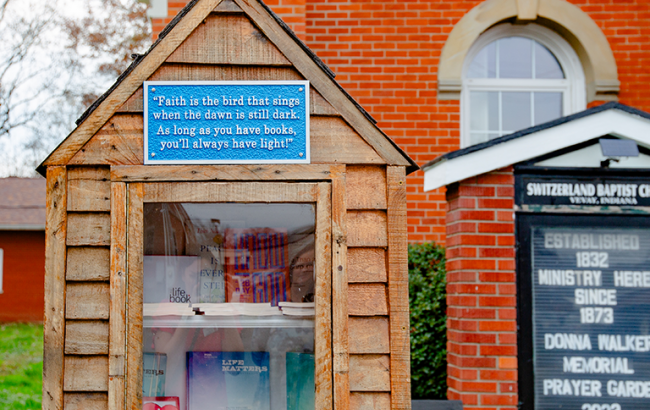“There are critically important challenges that the nation and the world are facing, and the whole point of the national laboratory system and mission for Oak Ridge is to answer those challenges,” Streiffer said, explaining that ORNL’s research portfolio offers significant support to the Department of Energy’s national missions in clean energy, breakthrough science and national security.
“One of the things that attracted me here is just how broad the mission really is and the capabilities that the lab brings to bear. There’s so much that goes on here.”
Streiffer has finished his first week on the job — his first day was Oct. 16 — but he has been receiving congratulatory calls and texts from friends and colleagues across the United States since being announced as the lab’s 12th director in July.
“One of the things that’s really struck me is how much what we do at Oak Ridge matters to Tennessee and the southeastern part of the United States,” Streiffer said.
As he begins leading the lab and its 6,500 staff members, Streiffer talked about his background, his excitement about the job and his perspective on the work ahead.
When you come to work in the morning, what do you look forward to every day?
One of the things I love about the laboratory complex as a whole is that everybody’s for the mission. Everybody’s working together to deliver things that really are major science, engineering and technology, things we need for the world. And at the end of the day, it always comes back to people and having great people. And that’s something I really look forward to here at Oak Ridge.
ORNL is the largest of the 10 national laboratories that are a part of the Department of Energy’s Office of Science. What was your path here?
I grew up in Baton Rouge, Louisiana, and I remember watching the Apollo moon landing as a very young boy. This left a lifelong impact on me, not just about the excitement and joy of discovery science, but on the crucial role that engineering and delivery play in achieving the mission. To explore the frontier, you first have to build the tools that will take you there, and succeed in the journey.
Most of my career has been spent at Argonne National Laboratory. I was there for 24 years. I came in as an early career scientist working in the Materials Science Division, and then moved around the lab for a number of years. (At Argonne) I worked at the Advanced Photon Source as the director and then was deputy lab director for science and technology. I moved out to Stanford University about a year and a half ago, and this opportunity came up. How could one pass up a chance to come to Oak Ridge?
What distinguishes ORNL?
At the top of the list is the ability to deliver, to do great work and to actually get things done that matter to the country and to the world. In the science areas, it’s neutron science and computing, along with manufacturing and the materials capabilities here. The lab is known as the materials capability for the entire complex, and that’s really a lot of the history of the lab.
Energy technology, environmental and biological research, quantum and artificial intelligence, nuclear energy and isotopes – I don’t want to leave anybody out! – demonstrates how ORNL’s portfolio extends from fundamental science through its application in a variety of settings.
The extension of our capabilities to address critical national security issues is a great example of how we’re creative in applying our expertise to the needs of a diverse portfolio of sponsors.
ORNL’s nuclear research and isotope production date to the lab’s origins 80 years ago. That throughline is really interesting and really exciting. We still are building on the things the lab was originally founded to do, and it’s fascinating to look back at that history and continuity.
You played a key role in establishing the Advanced Photon Source at Argonne and served as its director. How will that experience help you at ORNL?
The act of operating a cutting-edge user facility — and we are privileged to have eight leading user facilities at ORNL — is a commitment to the users that that facility is going to deliver for them. Large, complex facilities like the Advanced Photon Source or ORNL’s Spallation Neutron Source and High Flux Isotope Reactor are used by researchers from universities, industry and other government agencies.
The ability of SNS and HFIR to guarantee that neutrons are there for their users requires not just the beamline scientist but everybody associated with those facilities, from people who are scheduling users, to people who are helping the users come on site, to the technical staff that maintain the accelerator and reactor complexes, to beamline scientists who are actually sitting here with the users doing science.
One priority at ORNL and any DOE facility is safe conduct of operations, and it’s something you’ve mentioned consistently in your early conversations at ORNL.
We need to be able to do our work and be at that absolute cutting edge of research and development, engineering and technology. But we have to do it safely. We have to be able to make mistakes — that’s how we figure out solutions — but we always need to make sure that those mistakes don’t have unintended consequences.
Any closing thoughts?
One of the things that I always like to remind people is leadership at the laboratory works for the people of the laboratory. It’s our job to make people successful and to make sure that we deliver on the mission. And it gets back to the people and making sure that they have what they need to succeed and that they like to come to work here.
UT-Battelle manages ORNL for the Department of Energy’s Office of Science, the single largest supporter of basic research in the physical sciences in the United States. The Office of Science is working to address some of the most pressing challenges of our time. For more information, please visit energy.gov/science.



